#Gülbahar Sultan
Explore tagged Tumblr posts
Text






KÖSEM & GÜLBAHAR & BAYEZİD
#muhteşem yüzyıl kösem#magnificent century kösem#muhteşem yüzyıl: kösem#mc: kosem#magnificent century kosem#muhtesem yuzil kosem#kosemedit#kosem sultan#kösem sultan#nurgül yeşilçay#gülbahar sultan#sibel taşçıoğlu#şehzade bayezid#perioddramaedit#periodedit#period rp#ottoman#period drama#periodedits#osmanlı#period#flawlessbeautyqueens#queensofbeauty#dailywomanedit#dailyactresses#dailywomen#sultan#osmanlı devleti#osmanlı imparatorluğu#costume
22 notes
·
View notes
Text

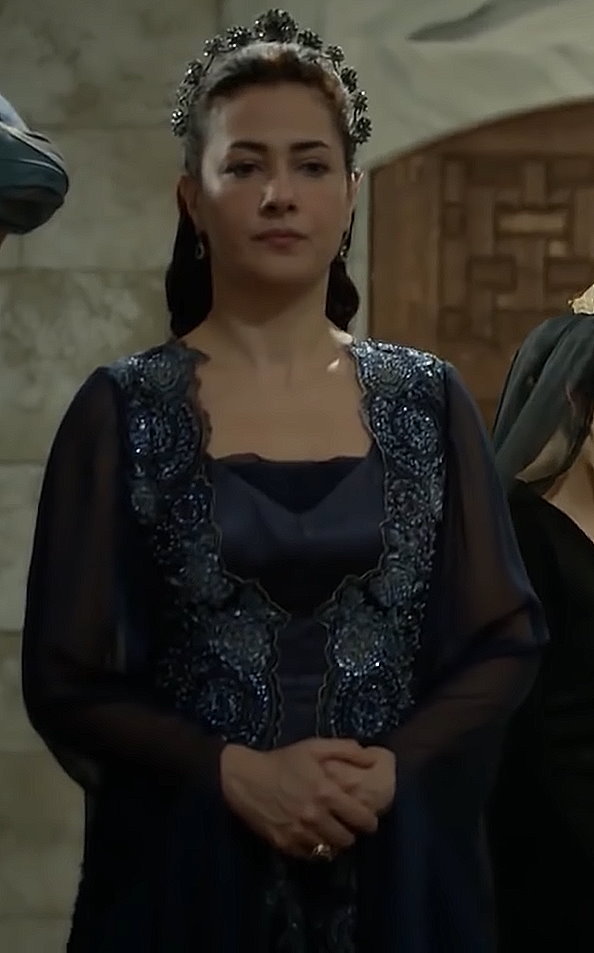


This dark blue and silver dress was first worn by Hürrem Sultan in the sixth episode of the third season of Magnificent Century. Like many other of her costumes, this one was also worn again by Fatma Sultan in the twenty-third episode of the fourth season.
The dress also appears twice in Magnificent Century: Kösem, first on Halime Sultan in the final episode of the first season and then again on Gülbahar Sultan in the thirteenth episode of the second season.
#Muhteşem Yüzyıl#Muhteşem Yüzyıl: Kösem#Magnificent Century#Magnificent Century Kösem#Magnificent Century Kosem#period drama#costume drama#historical drama#Hürrem Sultan#Hurrem Sultan#Fatma Sultan#Fatma Sultan (Daughter of Hafsa)#Halime Sultan#Gülbahar Sultan#Gulbahar Sultan#reused costumes#recycled costumes
32 notes
·
View notes
Text
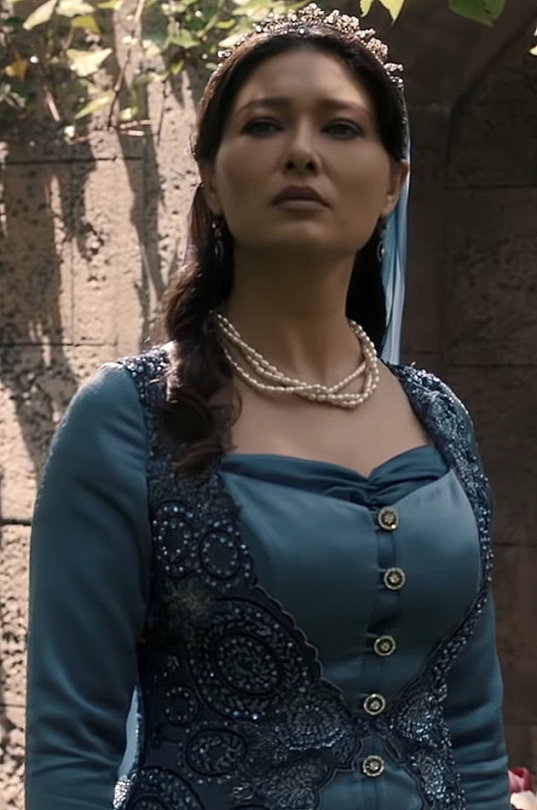
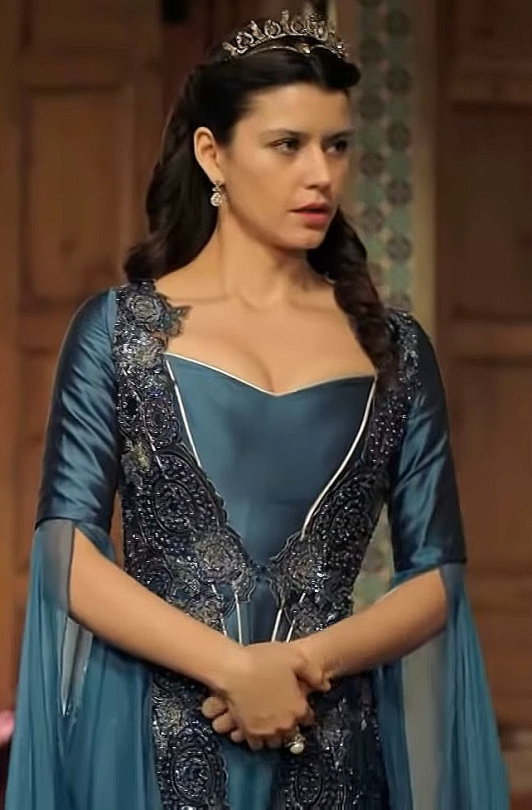
So Flashback!Kösem has joined the chat on my confusion and at this point I'm pretty sure these are two different clothing items. The patterns line up for young Kösem and older Kösem but I can't get them to line up with the other four without making the kaftan completely unwearable. However at this point I don't even think Hürrem's is a kaftan anymore but actually a dress. Usually with kaftans, the base dress tends to be different but I have seen this one only ever with the dark blue dress underneath. It would also explain why it always seems to stick so perfectly to the chest and stomach area when there is no clasp to hold it in place with tension. But if you have another theory, please tell me, because I have definitely spent too much time on this and I could probably convince myself of everything I want just to solve the mystery.
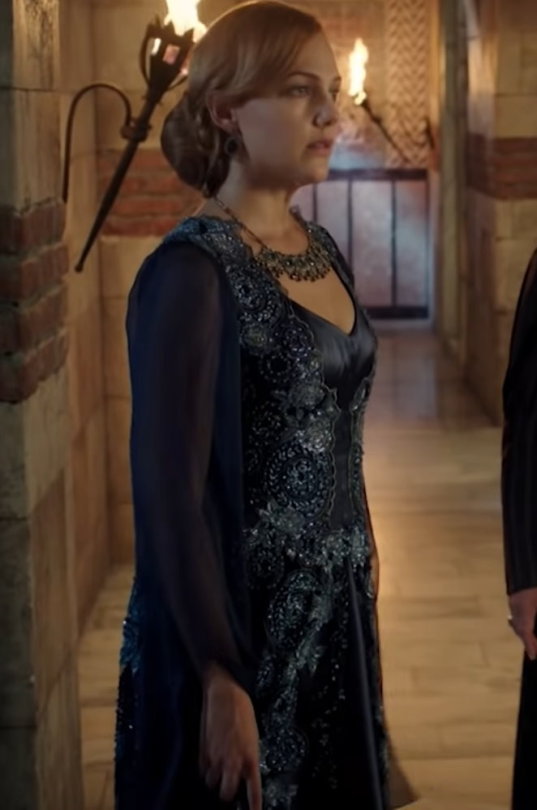
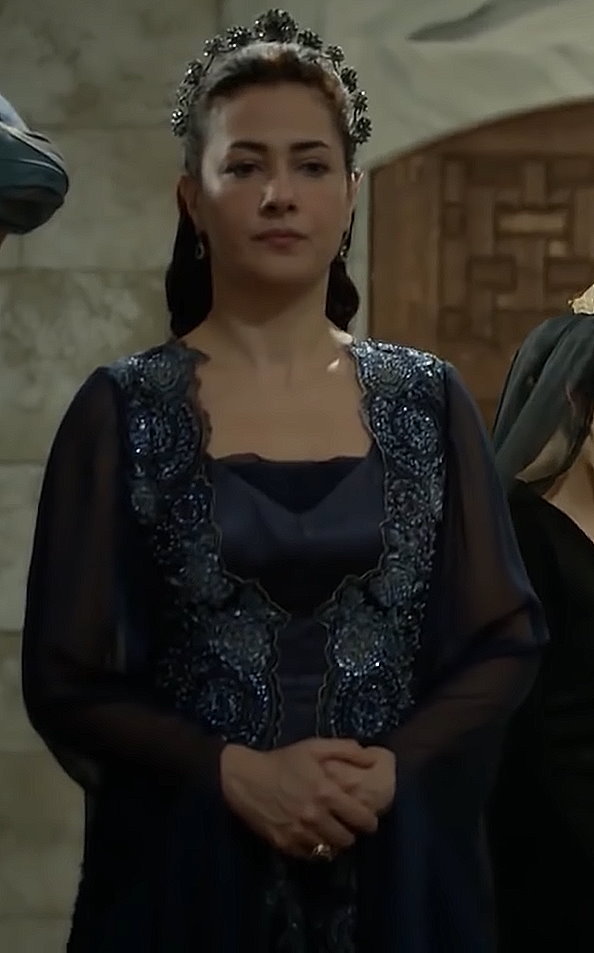
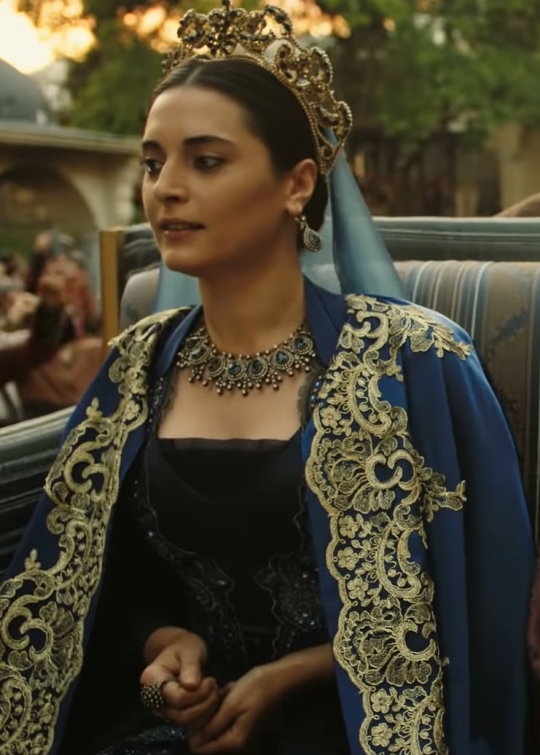
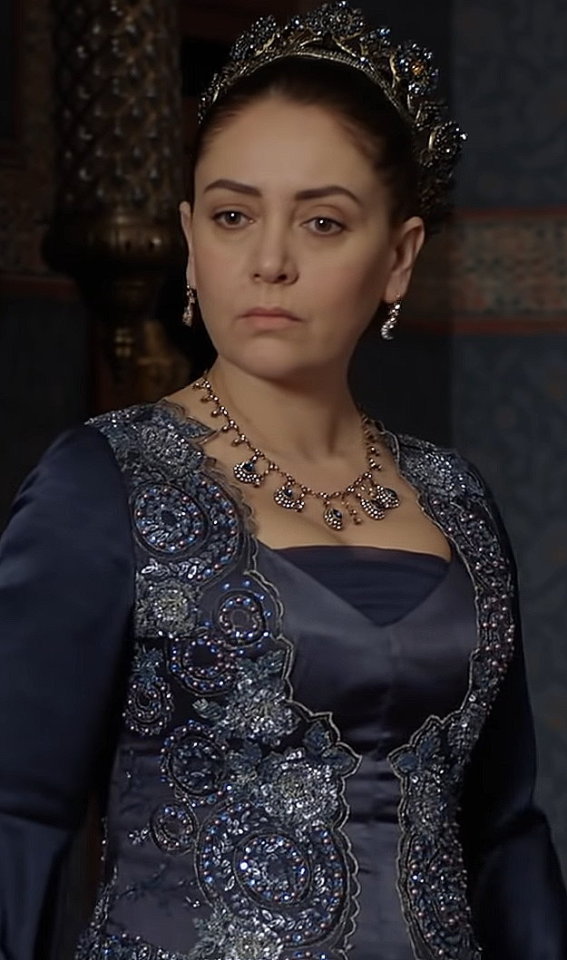
#Magnificent Century#Magnificent Century Kösem#Kösem Sultan#Kosem Sultan#Hürrem Sultan#Hurrem Sultan#Fatma Sultan#Halime Sultan#Gülbahar Sultan#Gulbahar Sultan
11 notes
·
View notes
Text




✭ Gülbahar Hatun (Seda Akman) — Fatih (2013) Ep.1
5 notes
·
View notes
Text



━━━━━━ 𝐌ahidevran 𝐆ülbahar 𝐒ultan : icons.
#icon#icons#turkish icons#magnificent century#muhteşem yüzyıl#el sultán#mahidevran hatun#mahisultan#mahidevran sultan#mahidevran gülbahar sultan#mahidevran sultan icons
5 notes
·
View notes
Text
Disputed noble background:

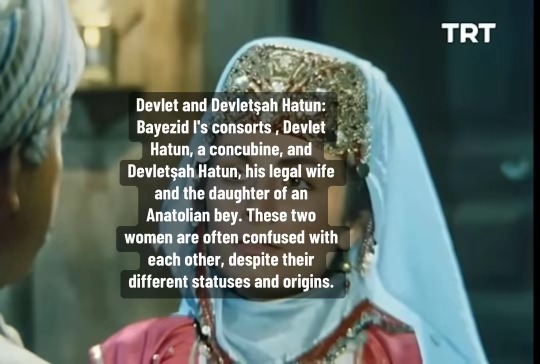
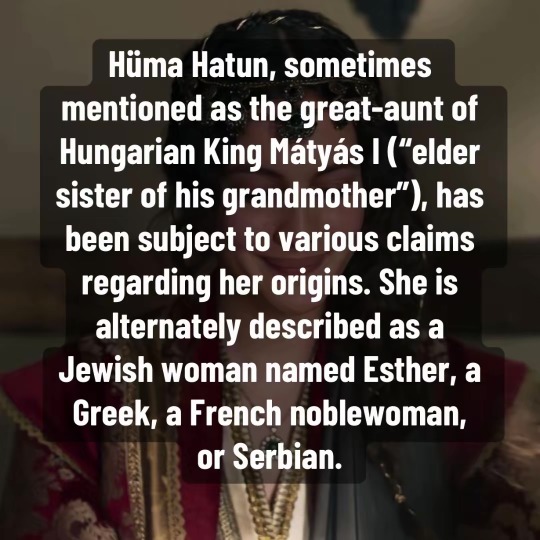


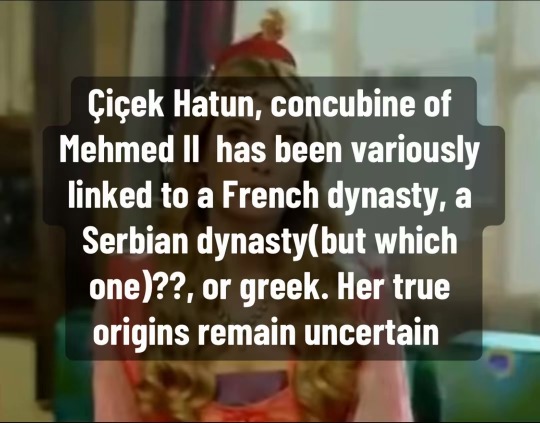
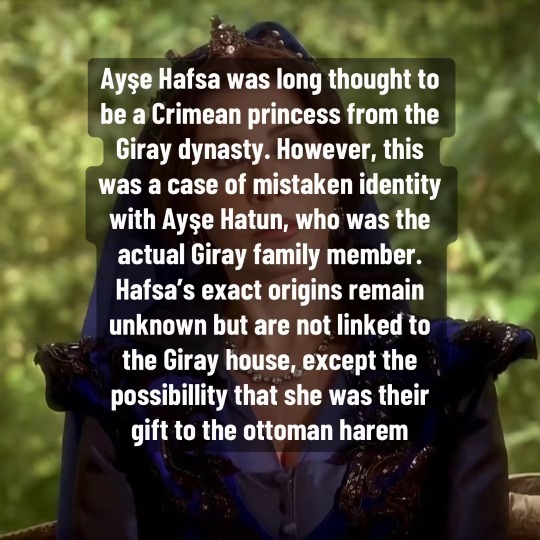
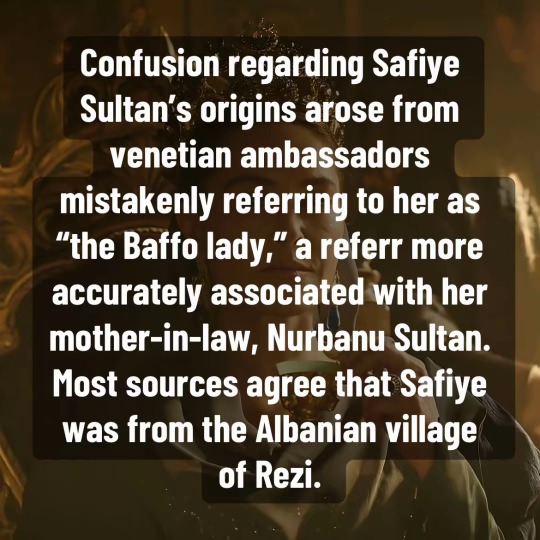
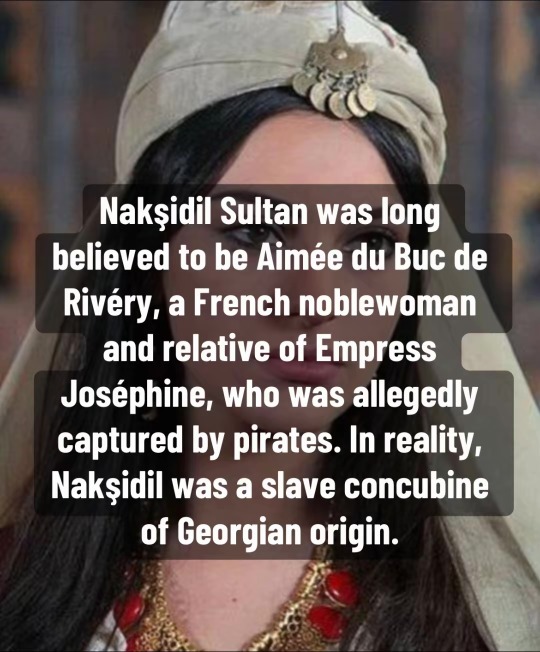
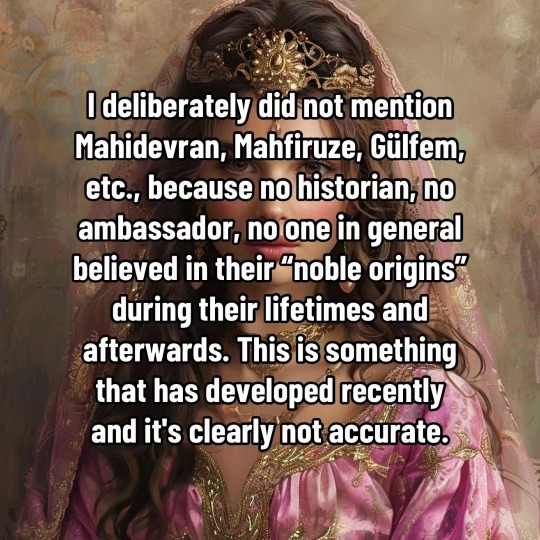
#ottoman empire#youtube#history#istanbul#hatun#hasekisultan#sultanmurad#sultan#consorts#fyp#fypシ#turkish history#tumblr fyp#asporça#ayse hafsa sultan#safiye sultan#holofira#nilüfer#gülbahar#gülşah#fatihsultanmehmed#sultan süleyman#mahidevran#hüma hatun#sultan murad#çiçek hatun#albanian#serbian#greek#byzantine
6 notes
·
View notes
Text
Yandere platonic father Fatih Sultan Mehmet and daughter reader.
Years ago.
Şehzade Bayezid had just turned seven years old. He was appointed as the Governor of Amasya this year. Emine Gülbahar Hatun went to Amasya with her son. However, it was revealed that she was pregnant before she left. However, she left Istanbul in order not to leave her son alone. Nine months later, Emine Gülbahar Hatun gave birth to a healthy baby girl. As the years passed quickly, the beautiful Sultan was growing up.
One day, Sultan Mehmet calls Şehzade Bayezid to Istanbul. Şehzade Bayezid is going to Istanbul Palace with his mother and sister. Sultan Mehmet does not know how to feel when he sees his daughter, whom he has never seen. They are chatting while they eat together. Sultan Mehmet is trying to learn about his daughter. While they are in the Istanbul Palace, Sultan Mehmet tries to establish a father-daughter relationship with his daughter. However, Sultan Pektr is not eager to form a bond with his father. There is more than one option for what happens next.
Sultan Mehmet does not allow his daughter to wear clothes anymore. So the Sultan will now live in the Istanbul Palace.
Maybe Sultan Mehmet can't stand his daughter's sadness and lets his daughter go.
If there is a second option, he will still visit his daughter. Or he will want his daughter not to visit him. He will not neglect to write letters.
#ottoman empire#ottoman history#yandere ottoman empire#yandere sultan mehmet#yandere sultan mehmet x reader#yandere male#yandere platonic#yandere parents
73 notes
·
View notes
Text
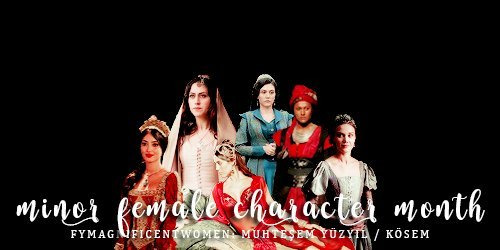
November November & December are Minor Ladies Months!
For the month of November, fymagnificentwomen would like to spotlight some of the less-celebrated women of Muhteşem Yüzyıl and Kösem, encouraging content that features characters with minor, guest, or supporting roles in the drama.
Who qualifies as a minor female character? For the sake of clarity, we’ll define minor ladies as those who are either not titled ‘Sultan’, or those who are but not listed in or directly after the opening credits. (An incomplete list of characters may be found below; questions concerning eligibility may be directed to the askbox).
Below is the list of some characters that you may use (for inspiration):
Sultanas and Imperial Mothers: Ayşe Hümaşah, Ayşe [mother of Nergisşah], Beyhan, Esmahan, Fatma, Nazenin, Nergisşah, Rana; Ayşe [daughter of Kösem], Fatma [daughter of Kösem], Hanzade, Hatice Muazzez, Kaya, Saliha Dilaşub.
Cariyes and Favorites: Ahsen, Ayşe [season 1], Cihan, Dilşah, Efsun, Elif, Esma, Firuze, Gülbahar (Olivia), Gülezar, Gülnihal, Helena, Nadia, Nazlı, Nilüfer, Nurbahar, Olga, Rümeysa, Sadika; Afitap, Elanur, Eycan, Firdevs, Gülbahar’s Girl Squad, Katerina, Mahfiruz, Nihan, Sanavber, Şayeste, Şivekar, Yasemin.
Palace Staff: Afife, Canfeda, Daye, Fahriye (Diana), Fidan, Gülfem, Gülşah, Gülşan, Melek, Nigar, Rakel; Cennet, Dudu, Ester Kira, Gölge, Lalezar, Madame Marguerite, Meleki, Menekşe, Narin.
Beyond the Palace: Anna Jagiellon, Armin, Aybige, Cehver, Eftalya, Elenika, Esmanur, Gabriela Sfenzi de Feo, Gracia Mendes Nasi, Isabella Fortuna, Isabella Sforza Szapolyai, Monica Gritti, Rita, Saliha, Silvia, Zeynep; Akile, Catherine of Brandenburg, Falcı, Kalika.
Content featuring relationships with major female or male characters is welcome, permitting there is equal focus on the minor character.
Finally, don’t forget to use the tag #minorladiesmonth to share your creations as part of this month’s event!
#magnificent century#muhteşem yüzyıl kösem#magnificent century kosem#muhtesem yuzyil kosem#mcedit#kosemedit#I know the month's ending#but if anyone posts something in December it's absolutely oki too!#minoradiesmonth
23 notes
·
View notes
Note
hi!!!! very exited for your take on all the ladies but i also wonder if there are any ladies from ottoman side you’re exited to write about?? have a nice day? :D
Dear Anon, thank you for this Ask! I am happy to see such a nice surprise from you in my inbox (the Ottoman part of the story is a real brainrot these days skdjsdksks). I hope the reply finds you somewhere on your dash! ❤️️
I do have to admit that I do not know just how many ladies from the Ottoman side will make their appearance as I do not yet know how much of Mehmed's story I will get to write. But here are the ladies you can look forward to in the future!
Hüma Hatun. Obviously, Mehmed's mother plays an important role in his life and will hence make an appearance -- definitely implicitly through Mehmed's character, but I would also like to explicitly include her character. Essentially, this part of her Wikipedia entry sums up my plans for her and her lore: "Based on the fact that Mehmed II was fluent in the Serbian language, it was concluded that she may have been of south Slavic origin, most likely Serbian." Essentially, both Vlad and Mehmed grow up in environments in which the sense of self and one's identity is regarded as being inherited from the father, with little regard for the importance of the mother and her own identity or imprint on her children, so just like I want to show Vlad as a son of both his father and mother, I want to apply the same to Mehmed. Because the Ottoman sultans were often sons of slaves turned into concubines, this might be even more impactful.
Mara Branković (also known as Mara Hatun). Mara was an incredibly powerful woman, both in her native Serbia and the Ottoman Empire -- her influence was so crucial that to this day, she is regarded as one of the most powerful women in the 15th century. Mehmed considered her a mother figure in his life, and she even came to play a significant role in several diplomatic negotiations during his rule. What I find very interesting and worth exploring is that she disrupts the typical idea of medieval women being passive, submissive, and always forced into the shadows because she was an important political player during the rule of two sultans. She was also one of the most prominent leading members of the pro-Ottoman party in the Balkans which is also an interesting thing to explore -- what exactly creates one's sense of belonging? Is home necessarily the place you were born in? What makes you grow loyal to your own captors? (I might digress here a little but Mahmud Pasha is another character I want to include who will face the same decisions -- and, funny enough, he is Serbian as well.) She will also make an appearance in Vlad's story as she will try to influence his worldview a little, both during his hostage years and later on.
Gülbahar Hatun. The great importance of Gülbahar's character actually came to the surface while I was reading Mehmed's biography -- I learned so much about her thanks to that, and since then, she has been a crucial character in his story. Even though Mehmed despised their son Bayezid his whole life, Gülbahar remained very dear to him until his death. Although the importance of his lovers (both female and male) fluctuated and changed depending on life and its circumstances, he considered Gülbahar as something of a constant presence, the person to be his rock. This is quite interesting, especially because Gülbahar loved their son deeply (she had great influence over him) and went to Amasya with him when he became the governor, as per the Ottoman custom. What is even more interesting is that, despite slaves in the harem being made to convert to Islam, Gülbahar allegedly remained a Christian. Because I have established Radu as the second most important partner in Mehmed's life, it will be important to explore the differences in dynamics, as well as see one relationship built on love and another on fear.
Other important ladies from the Ottoman side might include Mehmed's sisters and daughter, I would also like to write a little something about his "love story" with Helena Palaiologina (he allegedly fell madly in love with her for her beauty and took her as a concubine but never touched her out of fear she might poison him). I also want to recreate his conversation with Sara Khatun who was a skilled diplomat and the mother of Uzun Hasan, the ruler of the Turkoman Aq Qoyunlu state, and served as her son's ambassador during Mehmed's siege of Trebizond. Fearing that Mehmed was planning an attack on the Aq Qoyunlu after being done with Trebizond, Uzun Hasan sent his mother (together with many noblemen and gifts) to negotiate. Their negotiation took place while climbing the Zigana Pass on foot. Sara Khatun was particularly successful in her endeavours, and the conversation was allegedly a very intriguing one for both parties.
4 notes
·
View notes
Text



Some Costumes in Fatih TV series + Gülbahar Hatun's dark pink caftan and golden belt in Ep.1
#gülbahar hatun#seda akman#fatih dizisi#fatih sultan mehmet#fatih#perioddramaedit#periodedit#period rp#ottoman#period drama#osmanlı#periodedits#period#perioddramasource#perioddramagif#costume#fashion#movie gifs#gif#my gifs#historical drama#history#queensofbeauty#dailywomanedit#dailyactresses#dailywomen#edit#my edit#pink#episode 1
25 notes
·
View notes
Text
i see gulbahar continues the mahidevran saga of giving sensible advice about being careful of how the sultan will perceive his actions to her grown son, who continues to do whatever he thinks is right while dismissing the possible consequences because he did what he viewed as just
#though she is partially the reason for why murad ends up suspicious of bayezid in the first place#tbf i do feel like bayezid is depicted with more nuance than mustafa is. but he's definitely in that same vein as 'righteous prince'#well. maybe he just looks better in my eyes bc for some reason i cannot stand kasim#gülbahar sultan#gulbahar sultan#sehzade bayezid#mc tag#muhteşem yüzyıl#muhtesem yuzyil#muhtesem yuzil kosem#magnificent century#magnificent century kosem
9 notes
·
View notes
Text


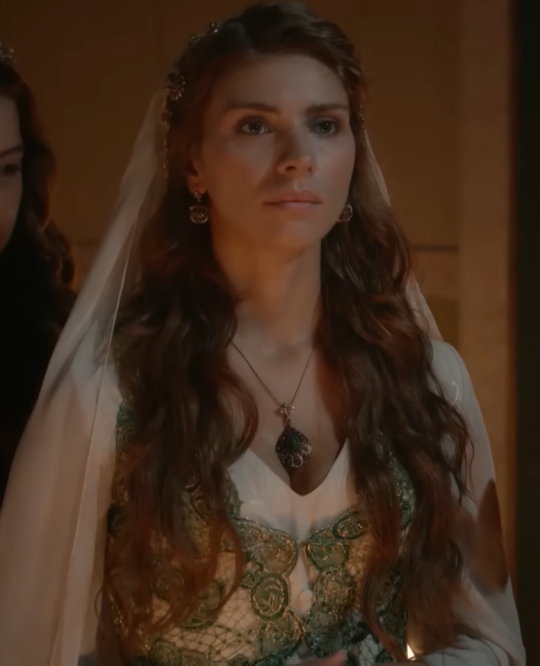

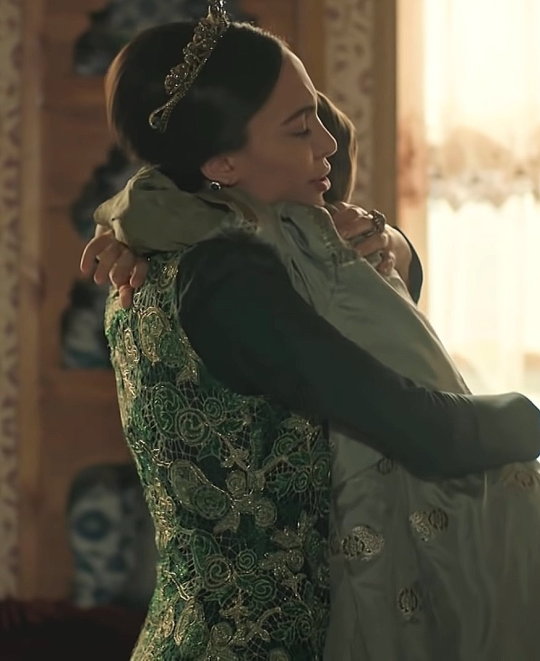
This golden and green kaftan was first worn by Hafsa Sultan in the third episode of the second season of Magnificent Century. It can be seen again on Mahidevran Sultan in the twenty-second episode of the same season. The kaftan is worn by an unnamed harem member in the third episode of the fourth season, before it can be seen on Nurbanu Sultan in the thirty-first episode.
Magnificent Century: Kösem used the kaftan on Gülbahar Sultan in the first season.
#Magnificent Century#Magnificent Century Kösem#Magnificent Century Kosem#Muhteşem Yüzyıl#Muhteşem Yüzyıl: Kösem#period drama#costume drama#historical drama#Hafsa Sultan#Mahidevran Sultan#Unnamed Harem Members#Nurbanu Sultan#Gülbahar Sultan#Gulbahar Sultan#recycled costumes#reused costumes
25 notes
·
View notes
Text
I think one thing I would change about the first season of Kösem is Katerina. Instead of writing her off, I would turn her into Gülbahar later. Gülbahar came out of nowhere at the end. I think having Katerina lingering around, always a thorn in Kösem’s side while behaving according to the rules, so everyone else thinks she is harmless, would have brought more to the character than someone we see for like three scenes and then suddenly is this massive character in the second season.
#Magnificent Century#Magnificent Century Kösem#Magnficent Century Kosem#Katerina Hatun#Gülbahar Sultan#Gulbahar Sultan
11 notes
·
View notes
Text
Remembering Gülbahar, part 2/2 - Wooing
Description: Continuation of my version of Mahidevran's backstory. Now an oops all Mahidevran x Süleyman fic. TW: what might be implied SA?
***
Around half a year after Süleyman’s arrival, he came to Istanbul once again, if only for a short visit – his younger sister Şahuban was to be marry Lütfi pasha. Of course, Ayşe Hafsa was to attended the wedding as well, and surprised Gülruh and Mahidevran were chosen as part of her entourage, which otherwise only included four slave girls, the other two being much older and more experienced. While at the time she was baffled by the great honor she’s been bestowed with, now Mahidevran suspected Ayşe Hafsa always had ulterior motives with Zahide hanim’s girls. Even back then, she might’ve figured it out sooner if such a thought wasn’t an act of immense hubris under the circumstances. As if Ayşe Hafsa would consider lowly Mahidevran hatun good enough for the possition of a concubine!
As it was, Mahidevran was filled with happiness as she marveled at the size and beauty of the then still in construction Topkapi palace, secure in her mistress‘ confidence in her as never before. This was especially important, because Ayşe Hafsa never sought to build a close relationship with her servants, aside from of Daye, and if she noticed them at all outside of giving them orders, she tended to treat them as a nuisance. Unlike Hürrem, who quite open and proud of the origin of her name, Mahidevran rarely talked about it, hoping people she met never heard of her as Gülbahar, because it was almost embarassing – Ayşe Hafsa often mixed up the names of her, Gülruh and Gülfem, to her own chagrin. In the end, she proclaimed that Gülruh was to be named Hüsnimelek and Gülbahar Mahidevran, and didn’t even bother to explain to anyone why did she chose those two names. Mahidevran, though humiliated by said careless name change, soon adjusted to it, simply because she did like her new name better, and it eventually helped her erase this period of her life from the memory of everyone else. Untill Gabriela’s audacious request, Mahidevran liked to pretend everything that came before that sunny, unusually dry autumn simply did not exist.
Mahidevran was at time so swept up in the pomp of the celebrations and beauty of the bright, rich colours autumn leaves gained in the persistent sunlight that she barely even noticed the wedding was actually a rather somber occasion. In fact, upon reflection, she certainly perceived the similarities between weddings of Şah sultan and Mihrimah sultan, even if the former wasn’t nearly as ostentatious as the latter. Şah’s unhappiness had rubbed on Süleyman, who expressed scepticism about the match quite often, much to his father’s irritation, but ultimately was powerless (and possibly unwilling) to stop the wedding. He tried his best to support his sister troughout this miserable ordeal, but ultimately, Süleyman seemed more bored and annoyed than anything. Despite their best efforts, the royal family gave off the impression that none of them wants to be there, and şehzade Süleyman was no exception. This must’ve strenghtened the resolve of Ayşe Hafsa to put in motion a plan she most likely had in mind for a while.
On the first morning of the seven-day celebrations, she sent all of them away besides Hüsnimelek and Mahidevran. This immediately made Mahidevran’s heart beat faster, as she wondered whether they earned some kind of punishment, reward, or perhaps an important task. It turned out that depending on one’s perspective, it might’ve been all three. „My son has been in a foul mood lately, and I wish to please him, but he isn’t very receptive towards the charms of harem girls these days. I haven’t been able to change his mind on this, but mayhaps such beguiling young creatures as you might. Thus, I wish to declare a contest between you two. Whichever one of you manages to obtain even the most miniscule expression of favor from our şehzade, even if it isn’t outright purple handkerchief, will earn a prize; and if by any chance you are called upon halvet, you shall be my most favoured of the concubines. If you do not succeed despite your best efforts, I won’t begrudge you, but should I notice you not trying at all, your disobedience shall not go unpunished. Understood?“ When they nodded their heads, trying desperately to hide their excitement, she moved her hand in a lazy gesture. „Off you go, then. And good luck!“
As soon as they left their mistress‘ apartments, Mahidevran collapsed to the floor, shaking and on the verge of crying. Frightened Hüsnimelek sat on her heels next to her. „Mahidevran?“
Mahidevran wiped away the wetness slowly clouding her gaze with her sleeve and managed to stop more of it from coming to the surface of her eyes. „Why must she torment us like this?! Does she not see...“ She didn’t even finish that silly thought. Of course she does not. What should Ayşe Hafsa, daughter of the Crimean khan and wife of the mighty sultan Selim, care for the banale friendships of slave girls?
„I don’t think it would help much even if she did. Now, get up, god forbid someone important sees you like this – sitting in the hallway crying...“ she said gently, extending a hand towards her.
Mahidevran hesitantly took it. „I am not crying.“ she proclaimed in a somewhat shaky voice, trying desperately to sound proud, even imperious. When she was finally standing on her own two feet, she looked into Hüsnimelek’s face and realized her friend isn’t calm, as she initially asumed, but tired and somewhat upset.
She awkwardly slipped around Hüsnimelek and resolved to leave her vicinity as quickly as possible, preferably for good, only for her friend to exclaim in an irritated tone. „Are we not going to talk about this?!“
„What is there to say?! Her Majesty wants us to not be friends, so what can we do?!“
„She didn’t say anything like that, Mahidevran.“
„But if we want to fulfill the task she has given us...“
Hüsnimelek stuck out her lip defiantly. „We’ll find a way around it, I am sure! If only we work together... Reach some sort of agreement...“
„What kind of agreement?! Her Majesty’s instructions were clear – we are supposed to be rivals in this contest...“
„A contest where there is nothing to lose.“ Hüsnimelek spat out contemptously. „So what if one of us becomes the prince’s favourite? The other one will still be in the service of Her Majesty, and either gets a good husband, or a the possition of a kalfa. I don’t know about you, but I wouldn’t be offended if you were blessed with the purple handkerchief – on the contrary, I would be happy for you! Wouldn’t you be happy for me too, Mahidevran?“
Mahidevran pursed her lips together, imagining the scenario. „I hope I would, because I already know I won’t win. How could he notice me over you, the most beautiful woman in this entire harem, who is also so clever and cheerful and lively...“
„Oh, that’s lovely. I am glad to hear that if you had to give away that godforsaken handkerchief, you would’ve chosen me.“ Hüsnimelek laughed. „But you don’t, şehzade does. And we can’t know which one of us he’d fancy if he noticed us, because he hasn’t yet.“
Mahidevran felt her mouth form into a small smile, and decided not to say anything. The more she thought about it, the more convinced she became she cannot possibly compare to Hüsnimelek with her waist-lenght hair the colour of a fresh hazelnut shell, round face with full pink cheeks, soft features and big aquamarine eyes with long lashes. And while her body was mostly slim just like Mahidevran’s, it was also graceful and had at least some curves, whereas Mahidevran was just thin and flat. No, she should not stand in Hüsnimelek’s way now. If everything goes well, she will be the mother of şehzade’s next child; if not, well... When Süleyman rejects someone like Hüsnimelek, what are the odds of Mahidevran catching his eye?!
It didn’t help that Mahidevran wasn’t very inventive. While she took Ayşe Hafsa’s instructions seriously despite the seeming hopelessness of her mission, she racked her brain for several days trying to think of how to catch Süleyman’s eye. Meanwhile, Hüsnimelek attacked with full force of her finest weapons from the very first day. That night, celebrations in the harem provided them with a good opportunity for a first strike – and while Mahidevran simply put on her best dress, did her best with the limited supply of beauty products she owned (Gülşah helped her with this and was helped by Mahidevran in turn, as was the custom between lower-ranking girls) and tried to dance as gracefully and seductively as possible (with mixed results), Hüsnimelek’s plan was much more sophisticated. After dancing as close to Süleyman’s line of sight as possible (somewhat foolishly, since he barely glanced at the slave girls having fun in front of him), she turned towards Ayşe Hafsa and acted as if she was trying to return to her side. However, on the way there, she very obviously faked slipping on a carpet and falling right into Süleyman, her stunning figure on full display to him as he just barely caught her before she could crash into his face. She then stared at him a little too long before she backed away and turned her gaze down. But Hüsnimelek didn’t even manage to appologize before Süleyman started acting as if nothing happened, jovialy continuing a conversation with one of his aunts present at the festivities. As Hüsnimelek‘s appologies went ignored, Ayşe Hafsa told her to not waste her breath and leave the room, which she did on the verge of tears. However, when she saw worried Mahidevran follow her out of the room, she quickly adjusted herself and went to the common sleeping area poised and calm-looking.
While this first unsuccesful attempt left Hüsnimelek sad and disappointed for a night, the very next morning she was already plotting another one. This time, she wrote a love poem, which she then left in prince’s apartments, hoping he would inquire who wrote it. He likely didn’t, and Daye spoke to the entire harem that afternoon, scolding the poem’s anonymous author for bothering the prince. That was an even harsher blow towards Hüsnimelek’s pride than the previous night, no matter how fervently Mahidevran swore her poem was one of the best she’s ever read. She wasn’t even lying; of course, what Mahidevran didn’t tell her friend was the way she was dying of jealousy reading it, knowing that she herself would never be able to create anything so awe-inspiring. At the same time, she felt guilty for this jealousy and had her opinion of şehzade Süleyman sour somewhat. How can he not see the literary genius on display, how can he, who prided himself so on his culturedness, dismiss such a talent right in front of him?! Is it just because the poem’s author is likely a mere slave?
Nevertheless, after a day of sulking, Hüsnimelek managed to muster up courage for yet another attempt. Her voice, while by no means spectacullar, was pleasant enough, and she reasoned that if she chose a right song, she could make şehzade notice her by simply singing in his vicinity often enough. She tried enlisting Daye’s help in getting closer to him, even offering her a bribe, but no luck; the old woman knew about their mission, but was unwilling to help them, likely on Ayşe Hafsa’s instruction. At the same time, sultana kept Hüsnimelek busy the entire day, so she didn’t get the opportunity to execute her plan.
Mahidevran meanwhile made a half-hearted attempt to run into şehzade during her time off that afternoon, hoping he won’t take the collision too harshly – and that it will be witnessed by Ayşe Hafsa, then walking the gardens with him, so that her mistress cannot accuse Mahidevran of not doing what she was told. Indeed, she found şehzade Süleyman and his mother and managed to find a way to walk opposite them right as they turned the corner, so that it didn’t seem suspicious that she didn’t immediately stop and bow in their presence. Of course, she nonetheless bowed right after the collision, appologizing impassionately, which sultana and her son seemed to ignore at first (except for what Mahidevran would swear was a single angry stare from Ayşe Hafsa). However, as they walked past Mahidevran, she heard Süleyman casually ask his mother. „Isn’t that the girl who ran after that annoying one?“
„Yes, that is her. Why?“
„Do they know each other?“
„How should I know?! Do you think I keep an eye on which slaves are friends? Bah! Don’t be...“
„Well, they are your personal servants, aren’t they?“
„Still.“
„Oh, she’s still here!“
„Bismillah, she is listening in on us! I am going to...!“
„Please, calm down, mother. Hey, you!“
Mahidevran turned towards them, her hands shaking. She bowed deeply, eyes firmly pinned to the ground. „My prince?“
„Do you know that girl who fell on me a few days ago, during those celebrations?“
„Yes, sir. She is in fact a friend of mine.“
„Tell her, then, that her talents are wasted on vain attempts to gain my attention. Her poetry is magnificent, but I can already tell she could be quite persistent if she puts her mind to it, and I do not wish to be bothered by her my entire stay in Istanbul. I do not desire her, and she should get the thought of convincing me otherwise out of her head.“
What happened next could be chalked up entirely to Mahidevran’s tendency to act before she thinks, especially prominent in her youth. Against all rules, she lifted her gaze and let out a surprised. „Why?“
Süleyman raised his eyebrows. „Why what?“
Ayşe Hafsa seemed outraged. „How dare you question our şehzade?! Get out of my sight, you insolent...“
„Not before she answers my question, mother.“ said Süleyman coldly.
Mahidevran dropped her gaze to the ground once again. „I meant... Şehzade forgive me, I didn’t...“
„What did you mean by „why“, hatun?“ he asked impatiently.
Mahidevran thought she could die of shame. „I just... I... If you liked Hüsnimelek’s poetry so much... And since she’s also one of the most beautiful women there... Why are you so disinterested in her?“ She then added, hoping to lessen the blow. „I wondered. I shouldn’t have done so. Please, forgive me my insolence...“
Süleyman’s voice was half-annoyed, half-amused. „Stop appologizing. I wasn’t angry at your impulsive question, but if you keep appologizing for it, I might get angry yet.“
Mahidevran lifted her gaze in surprised, but then remembered herself and looked down again.
She bowed once more and was ready to leave, when Süleyman spoke once again. „I did not give you a leave, Mahidevran.“
Süleyman’s voice was deep and soft and to hear her own name from his lips felt like a caress. At that moment, Mahidevran felt a light shiver all over her body. She was affraid to do or say anything out of fear of yet another scolding, but at the same time even this kind of miniscule, somewhat indifferent interest in her from him felt like the highest honor Mahidevran has been given in her entire life.
„Will you relate my message to her, then, in those exact words?“
„Yes, my prince.“
„Alright, then. Lift your head up, I want to see your face when I’m talking to you.“
But he didn’t actually talk to her. When their eyes met, he didn’t say anything, instead looking at her intently for a while before nodding her head. „You may go.“ he said quietly, turning away as Mahidevran gave him her final bow. She didn’t leave, instead trying to listen in on them, but she only heard Ayşe Hafsa’s annoyed questioning of her son and Süleyman’s only response – laughter.
When Mahidevran returned inside, she felt a strange clenching in her stomach and her heart still beating faster than normal. While she managed to collect herself in time to return to her duties, she was somewhat absent-minded the entire rest of the day, at all times either remembering Süleyman’s words and thinking how best to relay them to Hüsnimelek, or daydreaming about his beautiful eyes and voice. She was sane enough to realize how silly it is, to think Süleyman would remember her as anything other than a servant he gave an order to, but a part of her could not possibly give up hope, especially since Hüsnimelek had already lost their little competition. Or such was one interpretation of what happened – really, when it came to Süleyman, was being thought of somewhat badly worse than not being thought of at all? Then again, Hüsnimelek’s loss could’ve been a catastrophe to Mahidevran, who in her own eyes simply could not compare to her rival. If she had no chance, Mahidevran had twice as little.
She talked to Hüsnimelek as they went to sleep in the common area. „I met şehzade in the gardens. The good news is, he read your poem and liked it. But... He is still asking you to stop pursuing him.“
Hüsnimelek’s expression was a mix of befuddlement and profound dissapointment such as Mahidevran had never seen before. „Allah, I knew it. I was too conspicuous, wasn’t I?“
„I suppose?“
„That’s what I get for desiring sultana’s attention more than şehzade’s. I wanted her to see that I am doing something so badly that I forgot what my mission was in the first place.“ After a little silence, she lifted her blanket to climb under it, but then stopped to talk to Mahidevran. „Was he angry at me? Do you think it’s completely hopeless?“
„I don’t think he was angry, but he definitely meant „stop trying to gain my attention“ as an order.“ When she saw her friend’s defeated face, she quickly added. „But I don’t think our mistress would want you to give up. At any rate, we should at least ask her...“
„I would rather not.“ Hüsnimelek sighed. „She saw that I’ve done everything in my power, and should understand that it wasn’t enough. Shouldn’t she?“
Mahidevran didn’t answer. She wasn’t in a mood to argue, and knew her friend felt the same, even if they both knew Ayşe Hafsa enough to doubt Hüsnimelek’s hopefulness.
Next morning, Hüsnimelek confessed to Mahidevran that she was giving up her pursuit of şehzade Süleyman for good. Mahidevran herself considered doing the same, although she didn’t voice it in front of her friend. Then again, perhaps she should show at least some token effort, to assuade the wrath of their mistress. She gained the golden opportunity to do so when Ayşe Hafsa sent her to bring şehzade snacks – that afternoon, one of his former tutors taught him matrak, and Süleyman allegedly only ate a small amount from his lunch, surely he’ll be exhausted if he engages in such a heavy excercise on an empty stomach...? Mahidevran thought that sultana must’ve been at least partly sincere (mothers are the same everywhere – she herself worried about Mustafa’s diet and other minor inconveniences that might befall him quite often), but at the same time, surely Ayşe Hafsa expected more of her than that...
Upon seeing Süleyman, what she was struck by first was the redness of his cheeks, heavy breathing and sweat glistening all over his face. He looked more alive than ever before, and the raw beauty of his visage made Mahidevran herself blush. When he walked up towards her, she bowed as deep and kept her eyes on the grass below as intently as never before.
„You’re Mahidevran, aren’t you? The friend of that clumsy girl who writes poems?“
„Yes, sir.“
He suddenly grabbed her chin and lifted her face to look into his, frankly, quite annoyed expression. Still, that touch made her shiver. „Am I truly so hideous that you’d rather stare at the ground when you’re talking to me?“
„Forgive me, şehzade!“ Mahidevran said in a somewhat higher and more nervous voice than usual.
„Have you told her what I ordered you to say?“
„Yes, sire.“
„And what did she say to that?“
„She will obey your command, my prince.“
Süleyman smirked. „We’ll see.“
He then turned away, arousing panic in Mahidevran; she knew she must do something, anything to gain just a little bit of attention, for her own sake and Hüsnimelek’s. In that moment, her tendency to not think before she says or does something struck again. „She told me to say goodbye to you, for now she shall perish of shame and broken heart.“
Süleyman turned back towards her, his eyebrows raised quizically. „Did she? What, is she ill? Or does she by any chance have a penchant for exagarating things?“
„No, my prince, she was completely honest! You see, she is not ill at present, but her constitution is fragile and the next few days, mayhaps even weeks will be very hard for her, even if she manages to survive them.“
Süleyman’s eyes twinkled with mischief. „Keep me informed about her health, then. I would loathe to cause the death of such a lovely girl.“
At that moment, Mahidevran found herself a go-between to the potential romance of Süleyman and Hüsnimelek – and she realized she didn’t like the thought one bit. Already she was infatuated with Süleyman’s beauty and spirited nature, and the touch of his hand turned her feelings from idle dreaming into darker, more possesive territory. She still wasn’t too optimistic about the possibility of experiencing his touch again, but heavens, she desired it more than anything else and the thought of her own best friend getting to feel much more than a single finger on her face filled Mahidevran with distaste unbecoming of a friend of hers. She thus didn’t inform Hüsnimelek about her encounter with Süleyman, instead lying that he barely noticed her – and surely enough, the next few days her friend held true to her proclamation of defeat, acting in a reserved and overly servile manner around şehzade. Unfortunately, Süleyman himself misunderstood it, as he revealed to her when he once walked out of his mother’s chambers and pulled Mahidevran aside. „She indeed looks quite melancholic. How is she doing? Is she healthy?“
„In perfect health, my prince, just a bit disappointed.“ said Mahidevran quickly.
„A bit?“
„Well, she is not one to speak much, you know? I cannot at present tell exactly...“
But her voice was somewhat shaking, and Süleyman noticed. „Are you lying to me, Mahidevran?“
His question threw Mahidevran out of the loop. „No! Majesty, what do you mean...?“
„You’re contradicting yourself, and even the tone of your voice is... Off. What does Hüsnimelek truly feel, can you tell me?“
Mahidevran blinked fast, startled by his accusations. „My şehzade, I swear, I am not...“
Süleyman looked displeased, making Mahidevran’s heart sink with despair. „Of course you can’t. I must therefore ask her.“
He tried to walk past her, but panicked Mahidevran stopped him. „Majesty, I lied the first time! She holds no strong feelings for you, and only aims to gain your attention because your valide ordered her. The poem wasn’t sincere...“
Süleyman smiled – a mischievious smile, young and heartbreakingly beautiful. „But it was truly moving, wasn’t it?“
He was close, so close, to Mahidevran, and yet also to her losing him forever. She couldn’t help herself. „It is not fair, it truly isn’t! Were I as good in poetry as her, I would’ve written you words a thousand times as moving, for I desire you so much more strongly, but I can’t, so you’ll never know...“
Süleyman let out a surprised laughter. „I certainly do now.“ His expression then changed into a more serious one, as he wondered out loud. „Mayhaps valide did send me the wrong servant of hers.“
Mahidevran felt an overwhelming desire to touch him, or heaven forbid even kiss him, but he only turned away, once again wearing his mischievious smile, and left Mahidevran’s proximity. In desperation, she touched her own lips, and upon imagining his fingers in place of hers, she let out a small sob. She felt like the biggest fool on the face of the Earth, and yet at the same time his comments filled her with more hope than she ever felt before. And the thought of possibly getting to know şehzade Süleyman biblically completely blinded her to everything else.
But the next few days came and went without anything significant happening on that front. Hüsnimelek continued her attempts to make Süleyman notice her as little as possible, while he didn’t seem to think much of either of them. And so, as the wedding festivities of Şah sultan and Lütfi pasha came to a close and şehzade was getting ready to go home, Mahidevran had grown desperate to arouse şehzade’s interest once again, and after wracking her brain with what she knew about şehzade, she finally arrived at a quite radical solution.
She got the opportunity to talk to Ibrahim on the last day of their stay at Istanbul. As luck would have it, Ayşe Hafsa sent her to retrieve from him an expensive turban pin Süleyman borrowed him for the festivities, which seemed to enrage her quite a bit. After Ibrahim refused to do so, confident in his assessment that şehzade wouldn’t want him to, Mahidevran decided not to press matter further, since it made her quite uncomfortable anyway. Instead, she bit her lip and quietly said. „I came here for our sultana, but I also need to talk to you.“
Ibrahim raised his eyebrows. „How come?“
„I know I cannot expect you to care for matters of the harem, and that it is not your place...“
Ibrahim smirked. „That is absolutely true... What is your name, anyway?“
„Mahidevran.“
„So, Mahidevran, if you already know all of that, what are you even doing here speaking to me?!“
„Because His Majesty trusts you like noone else, and if you took him to the gardens the morning after we return to Manisa, I would be extremely grateful. While I have little possesions, I would give all of that...“
Ibrahim’s response was sharp. „Do you have me for a common eunuch, girl?! I am not in the business of giving out favours to uppity little slave girls for pennies!“
„Ibrahim agha, you don’t understand! I was sent by Ayşe Hafse herself to persuade şehzade into, uh... More frequent fulfillment of his duties, I mean when it comes to siring an heir... If you helped me with that, you would most certainly earn her gratitude, and she’d forget the whole nonsense with the turban pin.“
„She’d forget that regardless. Knowing her, she soon forgets I exist too. I don’t matter to her any more than you do to me.“
„That’s not at all... Ibrahim agha, she is well aware of your exceptionally close relationship with şehzade Süleyman...“
Ibrahim’s voice suddenly took on a threatening tone. „Are you insinuating something by „close relationship“?“
Mahidevran gasped; she genuinely didn’t realize the possible implications of her words. „Allah, no! I meant... She thinks you are taking his attention away from women, but not in that way. That you are making him dream of anything but romantic avatures, not that you are yourself...“
„I see.“ Ibrahim said with fake thougtfulness. „And that is what our sultana genuinely thinks, not what you yourself assume, or have heard spoken about her alleged opinions from other slave girls, correct?“
„Ibrahim agha, I rarely leave her side, I’ve heard her say something along those those lines with my own two ears, multiple times!“
„But if I understand it correctly, you are revealing it to me out of your own volition, without your mistress knowing this, yes?“
Mahidevran was starting to get tangled in her own lies. „Well, I don’t suppose she would mind...“
Ibrahim raised his voice. „Oh, so you suppose?“ He leaned towards her. „If you truly need help with attracting Süleyman, all I can give you is a piece of advice. I did not strike a friendship with our şehzade by supposing or presuming what he thinks. I suggest you adopt the same attitude.“
It was then that a not-at-all discreet cough interrupted them. To her horror, Mahidevran saw Süleyman behind her back (the whole time, she was standing in front of Ibrahim’s doorstep). „Mahidevran, what are you doing here?“
While startled Mahidevran was collecting her thoughts, Ibrahim spoke up instead. „She came here to ask me for that godforsaken turban pin on your mother’s behalf, and somehow the conversation turned towards sultana’s opinions of me.“
Süleyman furrowed his brow. „Tell mother it is my wish for Ibrahim to keep the damn thing. If she wants to dispute my decision, she should do so to my face.“
„But, şehzade!“ Ibrahim gasped with a significant undertone of mockery. „This cannot do! Ayşe Hafsa already thinks you favor me too much and that this causes you to completely forget the issue of utmost importance – harem women.“
Süleyman’s mouth opened a bit in shock. „She thinks what now?!“
Mahidevran bowed as low as she could. „Şehzade, Ibrahim is insinuating something that is not true and that I myself told him not to misunderstand sultana’s words as...“
„What did you tell him, then?!“
„Well, Ayşe Hafsa obviously does not believe you and Ibrahim... You know she would not let such a horrible thing stand... But lately you don’t seem to have much interest in women and, perhaps, this might be caused by you seeking out other sources of entertainment... Goodness, not that kind of entertainment...“
Süleyman blinked fast in annoyance. „Mahidevran, what are you talking about?! Are you lying about what other people say or think again?!“
„I don’t believe so.“ said Ibrahim, grinning mischieviously. „She does not lie, merely assume.“
Mahidevran’s eyes filled with tears. „Forgive me, şehzade! It is true that our sultana is concerned about your lack of... Apetites. But she does not think Ibrahim is at fault in any way, at least to my knowledge. I simply wanted to get him on my side by trickery, and only made a fool of myself.“
„Your side? You’d defy your sultana so, Mahidevran? You yourself said she wished for Hüsnimelek to become my concubine.“
„Perhaps I misunderstood your words, then.“
„What words?“
„You... You yourself said... I know it was merely an offhanded comment, but... You said something about a wrong concubine...“
Süleyman laughed out loud in surprise. „Goodness, you’re bad at this.“
Mahidevran started sobbing. „Indeed I am.“
Süleyman’s features softened. „Now, there’s no need to be sad. Or cause ruckus, for that matter. You’re hardly the only slave girl here full of misplaced ambition...“
Words left Mahidevran’s mouth before she could stop them. „That’s not ambition!“
„What?“ said Süleyman flatly.
„I’ve told you. I do not this because I wish to come close to the glory of your blessed mother, or because I would dream about holding a prince in my arms, or even to have an ear of the greatest ruler this empire has ever seen...“
Süleyman smiled in soft mockery of her words. „You think that is what I’ll be, Mahidevran? How do you know? You speak it with such certainty, as if you were the Cumean Sybil herself, when noone but Allah above knows what the future holds. Just you wait, I’ll end up defeated in a battle with some vicious barbarian warlord and locked in a cage like Bayezit Yildirim, and what will you say then?“
Mahidevran realized that what she needs to tell him now is simply the truth. „That cannot happen. I know this, because I know you. I may be a mere slave, but I have eyes and ears, and I saw you every day strive for greatness and show the wisdom and fortitude to achieve it... I know your drive, ambition and fire, and I would follow it even to that cage or whatever, because I adore it, not any advantages they might bring me and you.“
Süleyman looked surprised by her words. „Girl, are sure you wouldn’t be a good poet?“
Mahidevran bowed her head. „I’ve tried to put into a concise poem, my lord, but the result wasn’t worth much.“
He then turned towards Ibrahim with a look of amusement. „Well, then. That’s a lot of words you just said; I’ll need a while to think about all of them. At any rate, you should go back to your mistress. We are leaving very soon.“
His words filled Mahidevran with anxiety. He was clearly trying to be mysterious, which could point to a wish for further relations. On the other hand, he could’ve just been having fun at the expense of a silly slave girl who thought he’d care about what she thinks of him. She sincerely wished she could discuss any of this with Hüsnimelek, but how would she even begin to explain the web of lies she tried and failed to set up, including at her friend’s expense?! However, Hüsnimelek couldn’t help but notice Mahidevran’s obvious distress, and her refusal to say anything only filled her with more concern. This in turn made Mahidevran prickly and throughout an almost two day journey a clear rift appeared between them. They didn’t have much time to think about it – on the road and just after arrival in Manisa, their duties kept them busy, and as soon as they were ready to settle into their old routines, things irrevocably changed.
She learned only later that Süleyman discussed their encounter with Ibrahim on the way to Manisa. Süleyman confessed to her (while caressing her pregnant belly) that he had conflicted feelings about his low apetites in amorous matters previously; after all, while noone (at least if their intentions were any good) wanted him to spend all of his free time in harem, he nonetheless needed more than one heir – besides it was somewhat healthy and expected for a man of his age and vitality to parttake in this kind of thing more often and with greater enthusiasm. Otherwise one might suspect that there is something wrong with him, either a hiden illness of the body or corruption of the soul. Mahidevran herself later encountered similar problem with Mustafa, but her son lacked the self-awareness of his father and seemed satisfied with his life of sexual moderation, bordering on deprivation. While Süleyman wasn’t yet ready to share such intimate concerns with Ibrahim (who to his knowledge had no sexual experience at this point anyway), he did confess that he found most encounters with concubines rather dull and technical matters, and that his meeting with Mahidevran filled him with hope that it might be different with her. At the very least, Süleyman took of a liking to her somewhat, which is more than he could say about all of the obedient, duty-bound ladies sent into his bed by Ayşe Hafsa before Mahidevran. To Mahidevran’s surprise, Ibrahim not only supported Süleyman’s decision, but went a step further and aroused romantic fantasies in his master by expressing hope that this new girl might in time become dear enough to him to make her way to his poems. He himself allegedly used to have a few semi-romantic encouters with a lady far above his station, but that relationship had come to naught as she was married to another man and shortly before her wedding, he and said lady had a quarrel anyway. Mahidevran wondered whether Ibrahim’s feelings towards this lady might’ve influenced his advice to Süleyman in some way, but she never learned more than what Süleyman told her then – besides vague rumors surfacing years later that the aforementioned lady was in fact Şah sultan (who furiously denied it).
At any rate, shortly after their arrival, Mahidevran was given the task of serving Süleyman and Ayşe Hafsa breakfast. The whole time, he was stealing glances at Mahidevran, untill he finally asked his mother if she considers any of her servants indespensible. Sultana cheerfully replied that none besides Daye, and was overcomed with joy when her son asked whether that includes Mahidevran. This made Mahidevran drop glass of water she was putting on a plate, earning a harsh scolding from Ayşe Hafsa – but Süleyman just laughed and requested his mother have her prepared that very night.
And that was all it took. But as fortunate as Mahidevran knew she was, the suddenness of her luck soon overwhelmed her. Lacking any preparation for the night awaiting her and still thoroughly convinced of her own mediocrity, Mahidevran spent the entire day barely holding it together. Surely, her first halvet cannot but go poorly, and then what? At best, şehzade will never even look at her again – but there’s also the possibility of her doing something so embarassing she will be banished or punished in some other way. In her worst moments, Mahidevran even thought she might displease şehzade so much he’d order her execution; a silly thought, but spoke to her own docility, anxieties and the general disposition of all servant women. Had she let her fear go unchecked then, it would’ve become a self-fulfilling prophecy, but she managed to avert her own doom by speaking with Gülşah (of all people!). While the woman was never known for her intelligence and clarity of judgement, her point of view in this case proved to be remarkably sober. She reminded Mahidevran that she has nothing to fear but fear itself and that if she displeases şehzade, she could at least find companionship in several women from the Manisa harem who seemed to have done the same, most of them trough no fault of their own. Gülşah’s deep disinterest in the matters of the royal chamber was refreshing after a day of stewing in her own anxiety, and eased Mahidevran just enough for her to realize that everything will most certainly go more smoothly if she starts looking forward to the night instead. Surely, in a few hours, she will be kissed. She will be held. She will get an opportunity to look and touch Süleyman, as much as she wants to, the more the better. Or at least that’s how she assumed these matters work, for some reason.
That evening, they dressed her in all white, in a rather common-looking (if certainly nice) dress, that she nonetheless chose to see as special; that silly thought helped her with anxiety too, since how could her life not change when she’s dressed in such splendor? Daye herself visited her before sending her off to Süleyman’s chambers, but she wasn’t very encouraging, just coldly instructing her on the relevant parts of the etiquette and making sure she knows about the basics of carnal matters. Mahidevran chose to not be bothered by her anyhow, focusing all of her attentions on Süleyman and the joy she’ll surely feel in his presence. Her doubts weren’t completely silenced, but their dillution sufficed to avert disaster.
After a formal welcome, Süleyman led her to the bed. As they sat, looking into each other’s eyes in silence, Mahidevran was convinced she is going to explode if she won’t relieve at least a bit of the pressure inside of her, and so she let out a loud, nervous giggle – but then almost folded under Süleyman’s quizzical look. Luckily, he then spoke out, saving her from further embarassment. „I see your hands are shaking. Is it out of fear or joy?“
Mahidevran gave him a small smile. „What should I fear when your majesty is with me?“
Süleyman absentminded took a strand of her hair and started winding it up on one of his fingers, slowly tugging on it just enough for her to feel it, but not to the point of pain; a threatening gesture? „Said Majesty, perhaps?“
Mahidevran winced. „Have I displeased you, my şehzade?“
Süleyman smirked. „How could you? You haven’t done anything.“
„And should I?“
Süleyman gave her a somewhat bored look. „I don’t know. Say something clever.“
„Well, then all is truly lost, because I am not terribly clever.“
„I suppose that’s not completely out of the question. If I am not mistaken, you did not even know who Bayezit Yildirim was.“
Mahidevran hanged her head in shame. „No, I did not. But I asked other girls, who payed more attention at the history lessons, about him.“
„And? What did they tell you?“
„That he used to be the ruler of this grand empire when it wasn’t quite so great yet. Before even Constantinople belonged to us. They say he was a man of such immense ambition and hubris that he faced Timur the Lame, the bloodthirty ruler of Samarkand. But pride comes before the fall, and so Timur defeated him in battle, captured him and inflicted all manners of terrible humiliations on him. I don’t even know if it’s all true; to hear them tell it, it sounds more like a legend than anything.“
„Bayezit Yildirim did exist, and was indeed defeated by the terrible Timur. Whether he truly made Bayezit’s wife serve him at the table naked, whether he put Bayezit into a golden cage fashioned into a carriage and led him trough the city streets like a Roman general on a triumph, whether he used the unfortunate sultan as a footstool... That I do not know. What I do know is that us Turks need some good historian, for a civilized nation like ours cannot live off of legends.“
„Well, I suppose that’s one more thing that when sultan Selim...“ Tension, slowly leaving her beforehand, came rushing back as she realized the dangerous territory she was moving on. „Not that I’d wish for such a thing, heavens no, but death comes for us all and hopefully you will be there to take the throne after him. And when that time...“
Süleyman gave her a tired smile. „You don’t even know how often I told myself that, but alas, my father is still alive and the longer he lives, the more things I leave for the time of my ascencion. As it stands, by the time he truly leaves this Earth, it may well be I won’t have enough time myself to do everything I wish I could do.“
Mahidevran gave him a warm smile and took his hand. „That would surely be the most unfortunate not only for you, but for all of the future generations as well.“
Süleyman tugged at her hand and brought it to his lips. „Or, maybe, it would be the opposite, should my ideas turn out to be terrible.“ he said with a devilish smile before kissing her hand.
Mahidevran blushed. „I wish I could help you tell whether that is the case. Alas, I lack the expertise... Whose judgement do you trust so? Your mother‘s? That of you teachers? Or perhaps Ibrahim agha?“
Süleyman snickered. „Mine most of all.“ And planted a deep, passionate, endlessly confident kiss on Mahidevran’s lips.
She thought the sheer bliss might kill her, or at the very least send her into a fainting spell. She thus grabbed his broad shoulders and squeezed them when he moved on from the lips to her neck. As a response to the squeezing, he wound his arms around her waist and caressed her back, slowly and gently. However, soon they moved forward, on her sides, and from them up, untill his thumbs idly caressed her small breasts. Only then did she realized the gravity of what was about to be done to her, and grew apprehensive. She was affraid that he wouldn’t allow her to pull back, but for once he did, leaving her blushing and appologetic. And so, she moved onto the bed and lied there, hoping it’ll let him do whatever he must – which turned out to be lying on top of her, unbuttoning her kaftan and more kissing, on the mouth, neck, the naked skin in the middle of her breasts, accessible trough a round hole in her dress between her clavicles and sternum. Soon, her impatiently unbuttoned her dress as well, which she then took off herself, along with the shift she wore under them. As she lied under him, blushing profusely, she decided to overcome her shame by helping him undress and touching him just like he did to her. After she took off his shirt, she reveled in the sights opened to her – kissing his broad, hairy chest and strong arms, her shyness slowly discipating as it was replaced by what she would now identify as arousal, but then was just a new, pleasant sensation coarsing trough her lower body. Still, it was quite a shock when he took off his trousers, spread her legs with one swift motion and just as uncompromisingly pushed herself inside her.
Mahidevran didn’t remember whether she reached the climax. She remembered liking the experience overall, but perhaps she had just forgotten any unpleasantness of that night; at any rate, she certainly cherished the other two times it happened that night more, mostly because she was much more confident and relaxed during. Their subsequent encounters lit such a fire within her young body that eventually, she was becoming too much even for Süleyman, which he seemed to take in stride – better to have a woman that is overeager than overly cold, he said, because a woman’s nature is better suited to deal with overabundance of lust than with its lack. Indeed, quite a lot of women he encountered seemed to suffer with some illness, that denied them natural impulses of this kind, he said. As she grew older and more knowledgeable, Mahidevran realized that his somewhat callous approach to concubines might’ve been to blame; Mahidevran herself could do with little prompting or stimulation, since she was completely smitten with him, but other women might not. (She tried to talk about these matters with Mustafa, but whether he took her advice to heart she did not know.) Either way, Süleyman at least didn’t begrudge his lovers this supposed affliction, mostly because he himself seemed to suffer from it, though meeting Mahidevran helped him greatly.
Still, while he enjoyed her company, he didn’t seem that attached to her and often sought out other women (which bothered her, but she could do nothing but cry to Gülşah about it), untill a smallpox epidemic hit around a year after he came to Manisa. It took little Murat and several slave girls, including Hüsnimelek, whose illness progressed so quickly Mahidevran didn’t even manage to patch up their friendship and say her final goodbyes. Süleyman thus found in her the ideal person to share his grief with; obviously, her losing a friend could not compare to the death of one’s own child, but she realized it and extended much more sympathy towards him than he did to her. And to his credit, he showed her care and understanding as well, something she’d never expect from a prince. It was only then that she gave her entire heart and soul away to him, and she didn’t manage to get it back for almost two decades.
Mahidevran wasn’t in a mood to reminescence about those happy couple of years that followed. She recalled them often, to the point that they now seemed like a book she read a few too many times. But this much needs to be said – he loved her, for a brief period, but he nonetheless loved her. He used to write her poems, shower her with gifts and compliments, and even let her bother him with her petty complaints, sometimes, when he was in a mood. For a time, he even eshewed other concubines, though that didn’t last, even before Hürrem came to his life. Perhaps she was foolish to think that this bliss would last forever, but how could she not when even the night before his departure he looked into her eyes with such love she would, at least for a moment, almost believe herself his equal? And for that matter, how was she to know she’d be replaced so suddenly and thoroughly?
It wasn’t of much importance in the present, anyhow. Mahidevran might have regrets about those days, but there was no denying they charted the course of her future forever, and brought her the arguably best thing in her life – Mustafa. For all of their little quarrels and cold shoulders he gave her sometimes, he truly was the love of her life (in some senses of the word), the one for whom she truly lived and should’ve done so all this time, just like Ayşe Hafsa tried to advise her all those years (though admittedly that was just what she meant, it came out sounding quite different, which is why Mahidevran never managed to listen to her). But such is life. Her old friend Ümmülgülsüm once said that in her country, they have a saying: „Everyone is a general after the battle.“ At least she knows what’s important now.
The morning after, during breakfast, she turned towards Mustafa with a smile. „It’s such a lovely day. Do you have much work now, my lion? I thought we might go for a walk in the gardens. I want to tell you a story.“
12 notes
·
View notes
Text
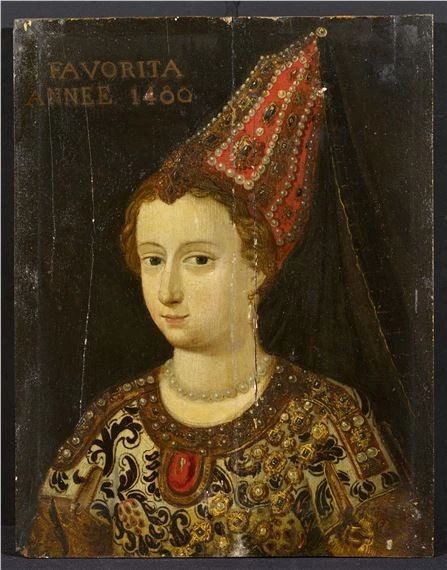
Emine Gülbahar Mükrime Hatun (گل بھار مکرمه خاتون; "benign", "spring rose" and "hospitable"; died c. 1492), was consort of Sultan Mehmed II, and mother of Sultan Bayezid II.
5 notes
·
View notes
Video
youtube
Gülbahar Hatun: The MOST POWERFUL Woman in the Ottoman Empire
You know, when we think about the power players in history, we often focus on kings, emperors, and military leaders. But let’s take a moment to shine a light on someone who played a pivotal role behind the scenes—Gülbahar Hatun. Now, if you’re not familiar with her, she was the beloved consort of Sultan Mehmed II, famously known as Mehmed the Conqueror. Yes, that’s right! The same Mehmed who transformed the Ottoman Empire into a formidable power. Gülbahar, which poetically means "Spring Rose," was no mere ornament in the royal court. She was a force of nature, deeply respected and influential. While there’s some debate about her origins—some say she was Albanian, others suggest a Bosnian background—what’s undeniable is her legacy. She wasn’t just sitting pretty; she was actively engaging in charitable works, commissioning mosques and schools that shaped the cultural landscape of the empire. Imagine the impact of a single woman’s vision on an entire society! Her tomb lies in the Fatih Mosque complex in Istanbul, a testament to her enduring presence. When you walk through those hallowed grounds, you’re reminded of the vital role consorts like Gülbahar played in the political and cultural life of the empire. They weren’t just wives; they were mothers, strategists, and leaders in their own right. So, the next time you hear about the grand narratives of empires, remember Gülbahar Hatun. Her story is a beautiful reminder that history is often woven with the threads of those who may not wear the crown but whose influence is felt for generations. Isn’t it fascinating how the petals of a Spring Rose can leave such a lasting imprint?
0 notes